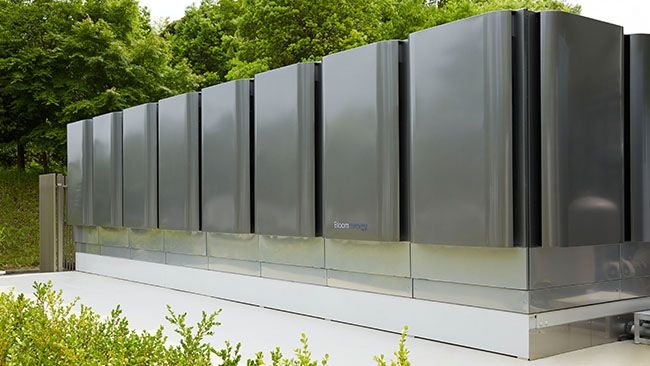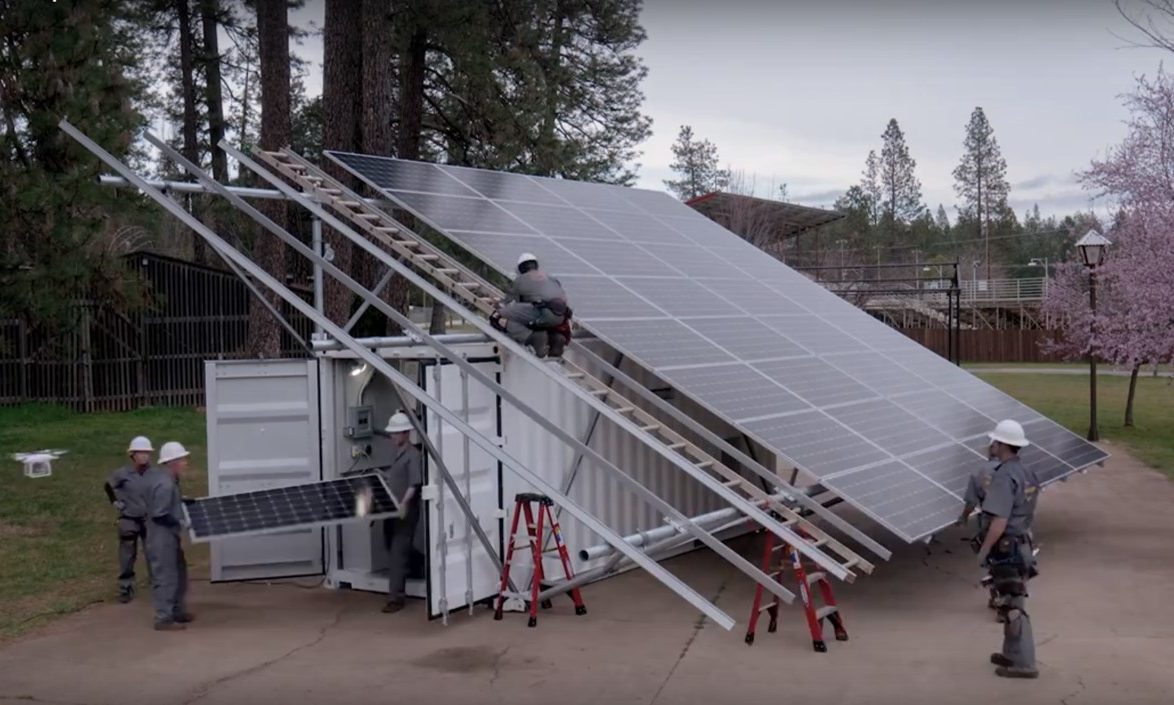7 companies making their mark with commercial microgrids

Installers prepare to mount solar photovoltaic panels on the BoxPower microgrid, which fits inside a shipping container.
Editor’s note: This is the second article in a two-part series about microgrids. The first part, discussing market dynamics, can be foundhere.
Increasingly, U.S. businesses are concluding that they need the type of business continuity, cost predictability and sustainability goal-aligned energy solutions that microgrid-plus-storage installations offer.
Here are seven companies hoping to capitalize on the interest in technologies that can serve commercial and industrial needs. While numerous software and services players are rising up to focus on this opportunity, this list (presented alphabetically) primarily highlights participants going to market with turnkey solutions.
AlphaStruxure
When the Carlyle Group and Schneider Electric announced their plan to create AlphaStruxure in April, the industry took note. It is not every day that one of the world’s largest private equity companies and a leading energy management and automation company join forces to seek out opportunities in the microgrid market.
With AlphaStruxure, the goal is to develop a partnership capable of taking on large, bespoke projects such as theJFK airport modernization project, which will use microgrids to transition the airport to 100 percent renewable energy, as well as modular microgrid-enabled energy-as-a-service solutions for C&I customers. For AlphaStruxure, "energy-as-a-service" means offering C&I customers energy solutions that include an initial advisory service, on- or off-site generation, energy efficiency upgrades, load optimization, contract structuring and capital.
"This means that we are accountable for the capital investment and the delivery of predefined outcomes that meet a customer’s goals for sustainability, reliability, resilience and cost-effectiveness," Juan Macias, AlphaStruxure’s CEO said, noting that AlphaStruxure will own the microgrid asset for the duration of the energy service agreement.We are ready to support a customer who needs a zero-capital-cost energy solution that delivers cost predictability, resilience, reliability and achieves sustainability commitments.
In 2020, AlphaStruxure plans to look for C&I energy-as-a-service opportunities in a wide range of segments. "We are ready to support a customer who needs a zero-capital-cost energy solution that delivers cost predictability, resilience, reliability and achieves sustainability commitments," Macias said.
Like the Carlyle Group, other private equity firms are exploring opportunities in this space. In July, BlackRock andGEannounced an agreement to build Distributed Solar Development, a new solar company that will design, build, own and operate distributed solar and storage solutions for customers.

Bloom Energy
When a heatwave and summer storms triggered power outages in New York last summer, Home Depot stores using Bloom Energy’s fuel cell microgrids stayed open, and other retailers took note.
"[Our] technology is well suited for retail companies… Because we use the natural gas infrastructure, which is a mesh network, and because our technology is on site, it’s able to power through extreme weather — blizzards, typhoons, etc. — providing electricity 24/7," said Asim Hussain, vice president in commercial strategy and customer experience at Bloom Energy.
与太阳相比,布鲁姆的微型智能电网"的技术has a small footprint. "[That’s] important for big box stores that have little space in the parking lot or on their roofs for microgrid technology," he said. Additionally, retailers also appreciate the cost predictability of Bloom’s installations, he said, noting that Bloom provides this in five to 20-year contracts.
In addition to retailers that can lose significant amounts of business during outages, Bloom is seeing a spike in interest from hospitals and the healthcare sector.
"Hospitals are required to have diesel backup generation, but we’ve heard that with the outages lasting longer than the fuel supply for their diesel generators, they’re looking for alternatives to their usual setup — and diesels are bad for the environment," Hussain said.
Kaiser Permanente is a large Bloom Energy customer for primary power, and it is considering options for microgrids.
BoxPower
Turnkey microgrid-plus storage systems have been having a moment in the wake of the California utilities’ recent public safety power shutoffs.
"After two weeks of outages and utility shutoffs, many businesses have had to shut their doors because of cash flow issues or because they lost their inventory at a critical time of the year," said Angelo Campus, founder and CEO of BoxPower, a startup that makes pre-engineered microgrid plus storage systems that can be dispatched and stored in shipping containers.
More climate-vulnerable companies no longer see small and medium-sized microgrids as a "nice thing to have," but something that they need to have, he said.
BoxPower is in the market with two turnkey microgrid solutions plus storage products, one that relies solely on solar power and another that uses solar power and natural gas.
"Solar and renewable resources are inherently intermittent, and many commercial clients want to know that they will have 100 percent reliability in the event of an outage," Campus explained. Hybrid solar/generator systems provide an ideal combination of cost savings from the solar and guaranteed reliability from the generator, he added.If you think of the potential applications for this, it will be applicable in areas hit hard by climate change.
In 2020, BoxPower’s C&I focus will be on geographies susceptible to extreme weather brought on by climate change, such as California, the east coast and the Caribbean. BoxPower is also looking for opportunities at schools and gas stations.
"It is less electric car-focused; gas stations fit our customer profile. They are the right size [for BoxPower’s turnkey microgrids]," he said. During outages, some gas stations rely on generators, but many have no backup power at all. "In Nevada County [California], there was only one gas station open during the last round of PSPS events, and there was a four- to six-hour line of people waiting to fill gas tanks for their cars and home generators," he added.
As a concept, BoxPower’s shipping container-based turnkey solar microgrid solution was a reaction to the 2010 earthquake in Haiti. Efforts to mobilize generators for critical services after that disaster failed because Haiti’s power system went down and the country experienced fuel shortages, resulting in many deaths from preventable disease due to the inability to refrigerate medicines and vaccines.

Eaton
When it comes to deploying microgrids, early movers in the commercial market often have been companies that already operate backup generators and/or emergency power systems. With this in mind, power management company Eaton has developed an industry-first solution that transforms emergency power systems used in data centers, and other commercial and industrial applications, to serve as a distributed energy resource.
This means data centers can use their emergency power system as a value-generating asset that can push or pull power from the power grid, said John Vernacchia, segment manager for renewable energy solutions at Eaton.
Eaton’s first project of this kind was done in collaboration with the Microsoft Innovation Center in Boydton, Virginia, using the Eaton EnergyAware UPS technology.
According to Vernacchia, the capability that this project demonstrates is important and relevant to the microgrid space because the ability to optimize and intelligently control distributed energy resources is at the heart of microgrid technology.
"Most, if not all, critical power facilities — like hospitals, data centers and manufacturers — have already invested in emergency power systems. This new capability gives these facilities the ability to perform microgrid system functions, including demand charge management, time of use optimization, demand response and frequency regulation," Vernacchia said.EVs will become a significant driver of the microgrid industry two to four years out, and they will need a place to charge.
It also can help facilities reduce electric bills and enable them to use more renewable energy resources, while also helping to support a more resilient electric grid, he added.
Data centers’ growing power demands are changing the requirements of the grid, Vernacchia said, noting that on a global scale, data centers use about 400 terawatts of power, or roughly 3 percent of all the electricity generated on the planet. Now, the battery systems used in data center emergency power systems can help stabilize the grid to balance the increasing use of solar and wind power, he added.
Gridscape Solutions
Based in Fremont, California, the city that is also home to Tesla’s automobile manufacturing plant, Gridscape Solutions is focused on solar-powered-plus-storage microgrids and electric vehicle (EV) charging systems.
"EVs will become a significant driver of the microgrid industry two to four years out, and they will need a place to charge," said Vipul Gore, president and CEO of Gridscape.
In many ways, it is convenient that microgrids and EVs are gaining momentum at a time when there is an urgent need for new investment in the U.S. power grid. There is a unique opportunity to introduce cleaner generation, while adding capacity and decentralizing the grid. In the face of the more extreme weather brought on by climate change, decentralizing the grid is increasingly seen as vital for resiliency.
"Battery prices and EV prices are both going down. [In the coming years] it will be important for automakers and fleet owners to leverage EV as a source of power during an emergency," Gore said.
The ability to discharge energy, as well as charge, would enable EV fleet owners to use — and in some instances monetize — their power.
在未来一年,Gridscape计划继续focusing on its microgrid-based EV charging stations and related services. It is also exploring ways to service hotels as they look to develop EV charging solutions for guests. "[Hotels] can put an EV charging station in front, so EVs can charge at night, and they can make money," Gore said.
Saft
It should come as no surprise that the French oil and gas giant Total and its battery energy storage subsidiary, Saft, are expanding in the microgrid space.
Last spring, Saft acquired Go Electric, an Indiana-based startup specializing in turnkey renewable microgrid solutions. Whereas Go Electric has focused on developing microgrid solutions for commercial and industrial customers, communities and military bases, Saft’s business has centered on storage for solar-diesel or wind-diesel hybrid microgrids for remote communities and mining companies.
To date, most of Saft’s microgrid projects have been for customers eager to save on fuel and lower their emissions, said Jim McDowall, senior technical advisor at Saft.
Saft and Go Electric are still functioning as separate groups.
Most large oil and gas companies have been investing in and developing renewable projects that involve storage, but Total is the only major energy giant that owns a battery manufacturer.

Siemens
Siemens plans to have its first microgrid cluster out this summer. In a microgrid cluster, multiple microgrids operating in a defined area are connected and controlled via a microgrid master controller that can optimize resources.
到达时,它也将成为第一个微型智能电网" cluster in the United States and the first commercial-sized microgrid project that will have bidirectional power flow, said Clark Wiedetz, director of microgrids and renewable integration for Siemens Smart Infrastructure USA.
The bidirectional power flow feature will allow Commonwealth Edison (ComEd) and the Illinois Institute of Technology (IIT) to buy and sell power to each other.
"If you think of the potential applications for this, it will be applicable in areas hit hard by climate change. And this is not a demonstration project — the Bronzeville microgrid will have 7 megawatts of generation assets, and IIT already has 10 MW. This is a good size to provide resiliency and reliability to communities," Wiedetz said.
The cluster would not really benefit any singular commercial or industrial client. However, when an area is hit by a storm, it isn’t just one company that is affected — it’s the whole neighborhood.
"You not only want your locations to keep running, but you want the people who work there to be safe and to have a place to go. It’s all about society. The concept of a community microgrid or microgrid cluster now comes into play for a C&I [customer] that is trying to bring resiliency to its employees," Wiedetz said.

